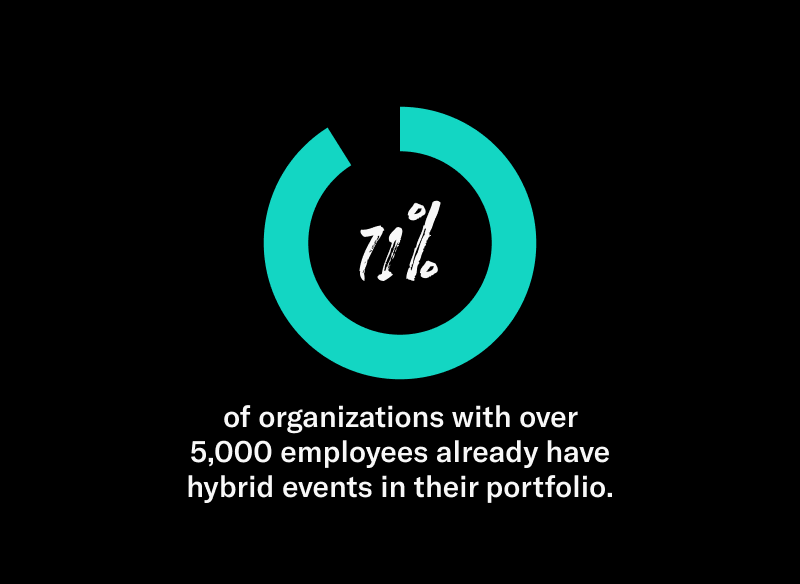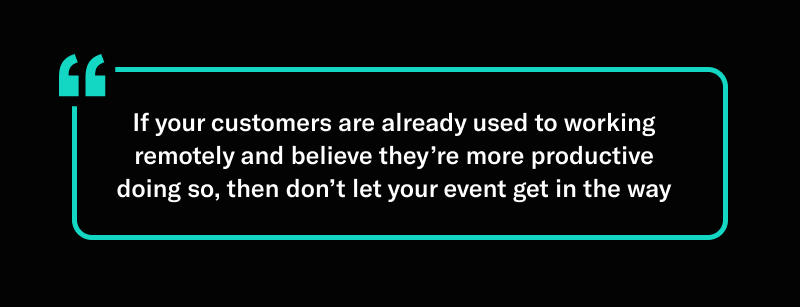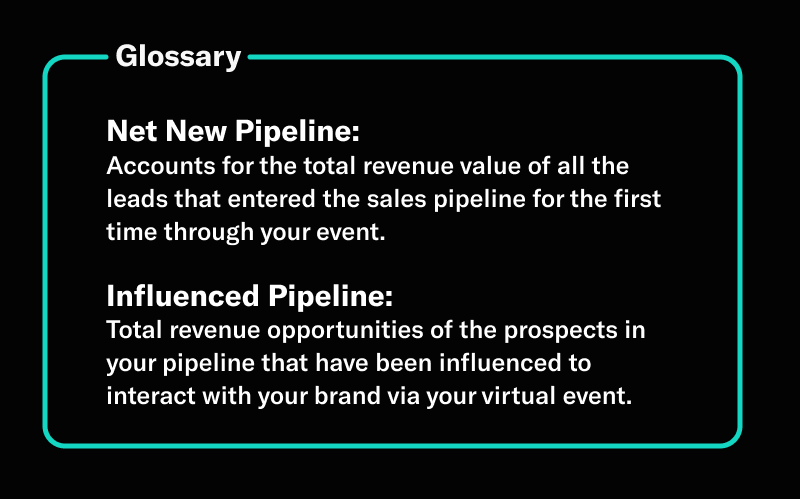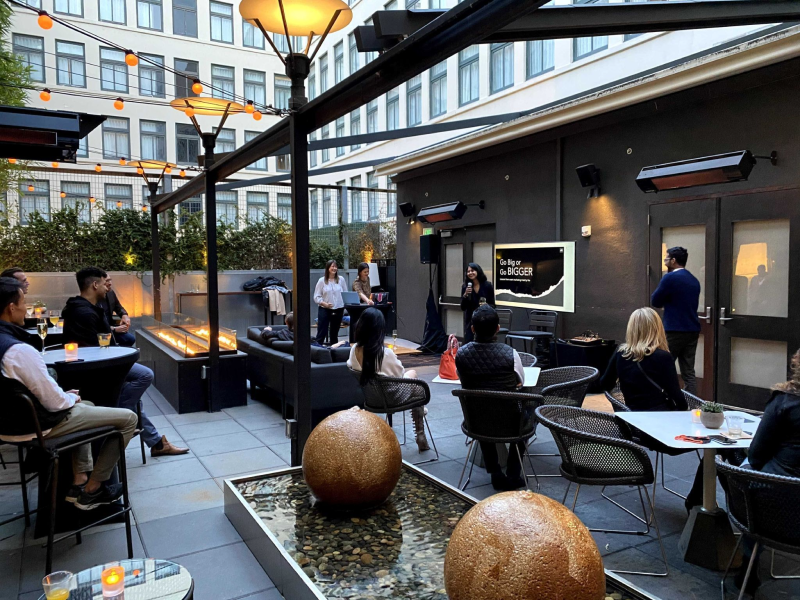The New Normal: 6 Reasons Why Your Next Event Needs To Be Hybrid

Maximize Your Marketing ROI
Join 10,000 other marketers already getting the best tips on running engaging events that boost pipeline and create raving fans.
Since Covid hit, the world of event marketing has changed forever.
In-person events have taken a back seat and flexible hybrid events are here to stay.
In fact, 71% of organizations with over 5,000 employees already have hybrid events in their portfolio. So, is it time to jump on the bandwagon and hitch your way to event-marketing success? Our answer: Absolutely.
“71% of organizations with over 5,000 employees already have hybrid events in their portfolio.”

Of course, we’re not saying you need to give up in-person events entirely. We’re not even saying you should give them up at all. But with 86% of organizations seeing a positive ROI from their hybrid event, it’s no wonder this part virtual, part in-person event format is fast-becoming essential to successful marketing teams.
You’ve done a lot of adapting recently, so we thought we’d make the switch to hybrid events that little bit simpler, with:
- A clear explanation of why hybrid events work so well
- A quick roundup of the benefits of hybrid events
- A step-by-step guide on how to prep, manage and measure your hybrid event
Ready to rock your next hybrid event? Let’s get into it.
What is a hybrid event?
Put simply, hybrid events are the pandemic-era lovechild of in-person and virtual events. One part virtual and one part live and in-person, these events allow for bigger audience numbers, more engagement opportunities and an all-round epic event experience.
On the flip side, hybrid events should not be defined by:
- The ability to view a live event on-demand
- Live-streaming an in-person event
- Hosting an in-person and virtual event separately, with different audiences and different content
Whether it’s a trade show, summit or company kick-off, hybrid events can (and should) be your go-to.
Here’s why.
Hybrid events = A modern crowd-pleaser
Hybrid events aren’t new. But, like every superhero, they’ve upped their game to save the day exactly when we need them.
Here’s why hybrid events are the next big thing:
- Hybrid events are more inclusive for people who can't make it to an in-person event.
- The flexibility of hybrid events allows for more day-of attendees.
- Compared to in-person events, hybrid events are more budget-friendly both for hosts and attendees.
- Venues capable of hosting Covid-compliant events are limited.
- Travel restrictions and reluctance to travel are prevalent concerns.
- In-person social interaction is still anxiety-provoking for many.
- Hybrid events cater to optional events and business critical functions.
- With nearly two-thirds of employees globally believing they’re more productive operating from home, the shift to remote working (and remote events) is clearly here to stay.
If your customers are already used to working remotely and believe they’re more productive doing so, then don’t let your event get in the way. Instead, host a hybrid event and improve the attendee experience by:
- Eliminating travel time and expenses
- Increasing productivity
- Anticipating safety concerns while accommodating remote attendees
“If your customers are already used to working remotely and believe they’re more productive doing so, then don’t let your event get in the way”
Running a hybrid event offers attendees a choice, something every customer loves. It means you’ve thought about them — their time, their concerns and their needs, and catered accordingly. Customer-centricity? Check.

6 reasons why your next event needs to be hybrid
1. Attract more attendees
Giving attendees what they want means more potential attendees. Those who can’t attend in-person may have more remote flexibility, whereas some people are thrilled to leave their WFH set-up.
Here’s how to measure attendee success in a hybrid event:
- Set and track registration numbers and, during the event, actual attendee numbers. Note: Hybrid events provide a great opportunity to blow those targets out of the water because of the expanded choice you’ve given your audience. 💪🏼
- Track attendee numbers through a sophisticated hybrid event platform to prove your value with hard data.
2. Maximize your pipeline
More attendees is great. But with94% of B2B event marketers using ‘Pipeline Generated’ as their key event success metric, segmenting attendees into Net New and Influenced Pipelines is even better.

Here’s how to maximize your pipeline:
- With Net New Leads, you can combine the potential deal size and revenue from each attendee to quantify the actual revenue potential your hybrid event brought in.
- With qualified, Influenced Leads you can total the number of attendee touchpoints throughout the event. For example, document downloads, break-out room choices, time in session, questions asked, polls answered, etc.
💡 Bonus tip: Depending on your goal, Influenced Pipeline can often be more important than Net New Pipeline. These attendees have purposefully interacted with your brand, increasing the likelihood of converting.
3. Build greater audience engagement
49% of marketers say audience engagement is the biggest contributing factor to a successful event. But awesome attendee engagement is tough to achieve and very easy to get wrong.
In a sea of webinars, virtual meetups and targeted marketing campaigns, you need to set yourself apart with a hybrid event that showcases your content and expertise in a seamlessly smooth way. How?
Prioritize a flexible event platform that offers robust engagement functionalities for your hybrid event that you can emulate in-person.
Here are a few ‘must-haves’ to look out for in your hybrid event solution to ensure both in-person and remote attendees have a memorable experience:
- Custom branding
- Polls
- Gamification
- Seamless video streaming
- Live chats
- Peer-to-peer networking
- Booths
- Deep integrations with other marketing tools

4. Access complete data
Marketing consultant and author, Geoffrey Moore, says, “Without big data, you are blind and deaf and in the middle of a freeway.”
In other words, if you want events to get the credit they deserve, you have to speak the lingo that matters: numbers, data and insight.
“Without big data, you are blind and deaf and in the middle of a freeway.”
The more attendees you have at your hybrid event, the more data you have to provide your sales team with. Think: which sessions they attended, how long they stayed, the questions they asked, which polls they answered, etc.
Tracking, managing and reporting on hybrid event data is hard. But with the help of a smart hybrid event platform, data can be integrated effortlessly into your existing sales systems like Hubspot and Marketo. From here, you can push targeted post-event follow-up campaigns and deepen existing sales conversations.
5. Improve ROI
With 52% of business owners believing event marketing has the highest ROI of all marketing activities, it’s no surprise data-fuelled follow-ups are the biggest ROI lever when it comes to events. Those insight-led, personalized and customer-centred conversations definitely drive revenue.
But there are also a few other reasons why event marketing is an ROI favorite:
- Hybrid events increase brand awareness: A hybrid event is the perfect time to offer attendees the branded event marketing experience that 74% of event attendeessay makes themmore likely to buy the product. Because it’s a hybrid event, you have double the brand exposure. Don’t forget to prioritize your branding.
- Hybrid events accelerate pipeline velocity and closed-wons: Hybrid events bring in new leads and speed up pre-existing lead conversion time. Here’s how:
- They shorten the sales cycle, and help facilitate next-step conversations with sales at the event, in person or in virtual booths — replacing lengthy email exchanges with 1-1 informative talks.
- They help provide interactive and engaging product demos.
- Hybrid events help your team understand customer pain-points more accurately, based on real-life data.
- They provide insights for personalized, deal-closing conversations.
- Hybrid events bring internal teams together: Strong sales and marketing alignment achieves a whopping20% annual revenue growth. The issue is, alignment rarely happens. But when it comes to events it simply has to. With sales on board to carry on the conversation your hybrid event will rule.
- Hybrid events are cheaper: There are a lot of overheads when it comes to live events: venues, catering, handouts, security, etc. For every attendee at a live event, the cost increases, whereas if attendees decide to attend your hybrid event virtually, it could save you big bucks bringing your total cost down compared to a fully in-person event.
6. Reduce your carbon footprint
Brand perception has a major impact on return on investment (ROI), with nearly 90% of shoppers staying loyal to brands that share their values.
Millennials and Gen Z are the green consumers the planet has been waiting for (go them! 💪🏻), so offering a solution that reduces the need for travel can only improve brand image, loyalty and revenue.
If you're a brand that prioritizes sustainability and green efforts, hybrid events show customers you’re making a conscious effort to be more sustainable.
“Brand perception has a major impact on ROI.”
Hybrid events are here to stay
The pressure for event marketers to bring the revenue is higher than ever before. You need more leads with greater deal value, who’ll convert quicker and retain each year.
That’s a tall order for anyone. But being the B2B marketing superhero you are, we know you got this. And hybrid events are here to help.
Hybrid events have brought a measurable marketing channel to an event industry that’s still finding its post-pandemic feet, and these events are totally at your disposal whenever you’re ready.
With a slick virtual event platform to help your hybrid event come together seamlessly, you can derive more data, greater value and deeper insights than ever before.

Transform Your Video Marketing with AI
Stay In Touch
Platform
Resources
© 2025 Copyright Goldcast, Inc. All rights reserved.





 Upcoming Events
Upcoming Events Event Series
Event Series On-Demand Events
On-Demand Events

